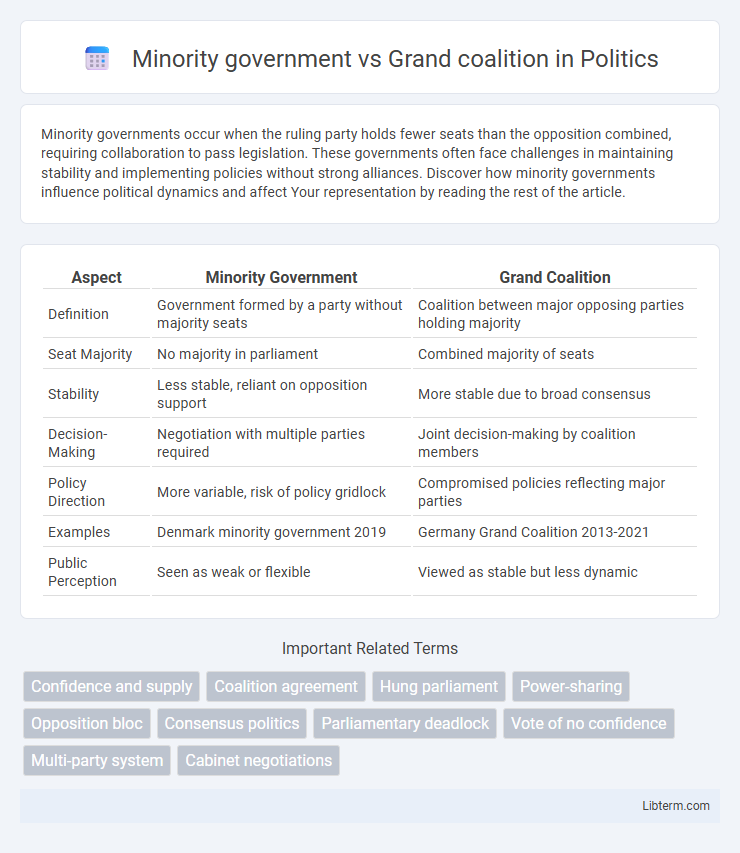Minority governments occur when the ruling party holds fewer seats than the opposition combined, requiring collaboration to pass legislation. These governments often face challenges in maintaining stability and implementing policies without strong alliances. Discover how minority governments influence political dynamics and affect Your representation by reading the rest of the article.
Table of Comparison
| Aspect | Minority Government | Grand Coalition |
|---|---|---|
| Definition | Government formed by a party without majority seats | Coalition between major opposing parties holding majority |
| Seat Majority | No majority in parliament | Combined majority of seats |
| Stability | Less stable, reliant on opposition support | More stable due to broad consensus |
| Decision-Making | Negotiation with multiple parties required | Joint decision-making by coalition members |
| Policy Direction | More variable, risk of policy gridlock | Compromised policies reflecting major parties |
| Examples | Denmark minority government 2019 | Germany Grand Coalition 2013-2021 |
| Public Perception | Seen as weak or flexible | Viewed as stable but less dynamic |
Introduction to Government Formation Models
Minority governments form when the ruling party or coalition lacks an absolute majority in the legislature, relying on issue-by-issue support from other parties to pass legislation. Grand coalitions, by contrast, consist of the two or more largest parties joining forces to create a broad-based government with a strong legislative majority. These models illustrate contrasting approaches to government formation, balancing stability, power-sharing, and policy compromise within parliamentary systems.
Defining Minority Governments
Minority governments operate without a majority in the legislature, relying on support from other parties to pass legislation, often resulting in unstable or issue-based alliances. They differ from grand coalitions, which comprise major parties joining forces to form a majority government, aiming for broader consensus and stability. The defining characteristic of minority governments is their dependence on negotiation and compromise with opposition parties to maintain power and legislative functionality.
Understanding Grand Coalitions
Grand coalitions involve major political parties collaborating to form a government, typically uniting the largest factions to ensure a parliamentary majority and political stability. Unlike minority governments, which rely on external support and face challenges in passing legislation, grand coalitions offer a broad consensus that can streamline decision-making and governance. These coalitions often emerge during crises or when no single party commands enough seats, emphasizing cooperation across ideological lines to address national priorities effectively.
Historical Examples: Minority Governments
Historical examples of minority governments include the United Kingdom's 1974 Labour administration and Sweden's Social Democrats during several terms in the late 20th and early 21st centuries. These governments operated without a clear majority, relying on support from smaller parties to pass legislation, often leading to negotiated compromises and policy moderation. Minority governments can result in increased political instability but may also promote inclusive governance through coalition-building efforts.
Historical Examples: Grand Coalitions
Grand coalitions, as seen in post-World War II Germany with the CDU/CSU and SPD alliance, exemplify efforts to stabilize governance by uniting major political parties across the spectrum. In South Africa, the Government of National Unity (1994-1999) brought together the African National Congress, the National Party, and the Inkatha Freedom Party to foster reconciliation after apartheid. These historical examples highlight grand coalitions' role in overcoming political fragmentation and ensuring broad-based policymaking during critical periods.
Advantages of Minority Governments
Minority governments offer greater flexibility in policy-making by necessitating negotiation and collaboration with multiple parties, which can lead to more balanced and representative decisions. They often result in more responsive governance as the ruling party must constantly engage with opposition groups to secure legislative support. This dynamic encourages transparency and accountability, reducing the risk of dominant-party complacency found in grand coalitions where power-sharing can dilute clear policy direction.
Advantages of Grand Coalitions
Grand coalitions, typically formed between major political parties, provide enhanced governmental stability and broad representation, reducing political polarization and fostering consensus-driven policymaking. These alliances enable efficient decision-making during crises by pooling diverse expertise and political capital, thereby enhancing public trust and legitimacy. Moreover, grand coalitions help prevent the fragmentation of the parliamentary system, ensuring continuity and effective governance in multiparty environments.
Challenges Faced by Minority Governments
Minority governments frequently struggle with legislative instability due to the lack of a clear majority in parliament, leading to difficulties in passing laws and implementing policies. The constant need to negotiate with multiple parties for support often results in compromised decision-making and delayed governance. These challenges contrast sharply with grand coalitions, which typically enjoy greater stability by combining major political forces into a majority government.
Challenges Faced by Grand Coalitions
Grand coalitions face significant challenges including policy gridlock due to conflicting priorities among major parties, which often complicates decision-making and delays legislative processes. The need to maintain broad consensus can lead to diluted policies, reducing the effectiveness of governance and frustrating voters expecting clear mandates. Persistent internal disagreements and compromises may undermine public confidence and weaken the coalition's stability over time.
Minority Government vs Grand Coalition: Comparative Analysis
Minority governments, characterized by ruling parties lacking a clear parliamentary majority, often face challenges in passing legislation and require support from opposition parties, leading to potential instability. Grand coalitions unite major political parties across the spectrum to form a broad-based government, ensuring a stable majority but sometimes diluting policy coherence and party identity. Comparative analysis reveals that minority governments prioritize negotiation and compromise for governance, while grand coalitions emphasize stability and shared power despite ideological differences.
Minority government Infographic

 libterm.com
libterm.com